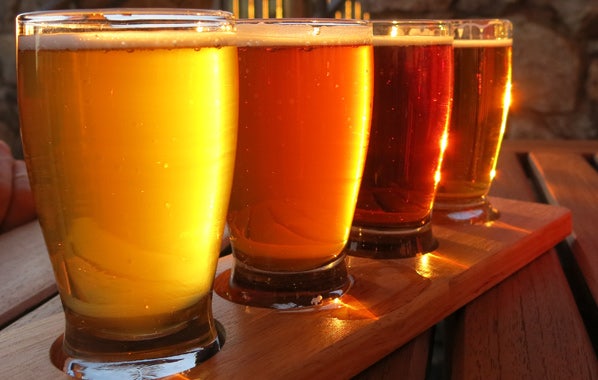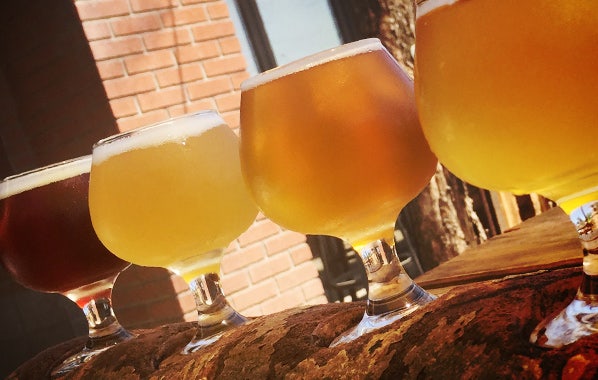How to Find the Best Pale Ale Recipe
History of Pale Ale
 Pale ale’s story begins with coke. No, not the soda pop, the fuel. Before coke became popular, wood and peat were used to roast malt. Wood and peat give malt a brown color and deep, smoky flavor – ideal for the porters and stouts popular to England at the time.
Pale ale’s story begins with coke. No, not the soda pop, the fuel. Before coke became popular, wood and peat were used to roast malt. Wood and peat give malt a brown color and deep, smoky flavor – ideal for the porters and stouts popular to England at the time.
In 1642, coke, a fuel made from coal, was first used for dry roasting malt. This produced a lighter variety of malt, one which didn’t have the smoky character of wood- and peat-fired malt. The beer that came from the coke-fired malt was much paler, thus the name “pale ale.” Though the term “pale ale” didn’t become popular until around 1703. By 1784, “light and excellent pale ale” was appearing in advertisements.
By the mid-1800s folks began referring to pale ale with a different name - “bitter.” It’s likely that brewery customers began using this term to refer to the beer because the hop flavors in it were much more apparent than those in stouts, porters, and other mild beers. During late 20th century, however, the “bitter” distinction was used to refer to cask beers, while bottled beers were “pale ale.”
Pale Ale in the US
Sierra Nevada Brewing Co. was founded in Chico, CA in 1979, and produced its first batch of pale ale in the following year. Sierra Nevada Pale Ale was revelatory for American beer fans. It emerged as a flavorful, crisp, aromatic and still markedly American beer – unlike the adjunct lagers dominating mainstream beer. This beer became the standard against which all other American pale ales, and many early microbrew beers were to be measured.
Pale Ale Styles
Cream Ale
Cream ale is known as a “lawnmower” beer because of its clean, dry, refreshing character. But don’t be mistaken, it still boasts much more flavor and aroma than standard American lagers.
Kölsch
Easily mistaken for a cream ale or a mild pilsner, this Cologne-born brew is known for being clean, crisp and balanced. Its subtle fruit and hop notes with light maltiness make it especially refreshing. Kölsch possesses a characteristic freshness, which keeps its delicate flavors and aromas intact.
British Golden Ale
Though British Golden Ale isn’t terribly similar to another pale ale, it is most like American Pale Ale. However, British Golden Ale has a lower ABV and is, of course, brewed with British ingredients. Compared to other British bitters and pale ales, this beer has less malt character (no caramel notes, fewer esters). Expect it to be hop-forward and moderately strong.
Australian Sparkling Ale
Australian Sparkling Ale is most similar to English Pale Ales, but with more carbonation & less caramel, making the yeast strain & hops more prominent. Smooth, balanced, and marked by the unique flavor of Australian ingredients.
Blonde Ale
Blonde Ale tends to be more flavorful than American Lager or Cream Ale, though less bitter than American Pale Ale. As with the previously mentioned pale ales, Blonde Ales are drinkable, clean, and well-balanced. Though there are memorable fruit, hop, and malt notes, no flavors in a Blonde Ale should be particularly bold.
American Pale Ale
Pale, refreshing, and hoppy – but not nearly as hoppy as modern American IPAs, or even most Session IPAs. American Pale Ale also has enough malt to bring balance to this beer, keeping it drinkable. When compared to its English counterpart, American Pale Ale tends to be a lighter color and lighter on the caramel notes, yet higher in ABV.
Belgian Pale Ale
Similar to English Pale Ale, but with unique yeast character and malt flavors. Belgian Pale Ale does not have the yeast character or aggressive flavor profile found in other Belgian beers. Instead, flavors of biscuit, toast, fruit, and honey make up the malt profile of Belgian Pale Ale.
Belgian Blond Ale
Belgian Blonde Ale has more in common with other Belgian beers, though it is sweeter and less bitter than most. It’s got moderate strength and a fruit/spicy yeast complexity, courtesy of the Belgian yeast used.
Saison
Imagine a drier, hoppier, and more bitter Belgian blond ale with more yeast character – that’s a Saison. The fruity and spicy character of the Belgian yeast is what sets Saisons apart.
Trappist Single
Pale, bitter, dry, and well-carbonated with Trappist yeast character. The Trappist yeast provides fruit & spice, while the hops boast floral spiciness, and the malt brings a grainy sweetness.
Pale Ale vs. IPA vs. DIPA

Think of this as a spectrum that will allow you to find the pale ale style right for your desired balance, and/or hoppy bitterness threshold.
▪ Pale Ales – Oftentimes Pale Ale promises malt-to-hop balance, though hops are certainly detectable.
▪ English India Pale Ales – Hoppy and brewed with English hops that give spicy, woodsy, earthy flavors.
▪ American India Pale Ales – Hoppier than English IPAs, and brewed with American or New World hops that provide piney, citrusy, almost grapefruit-ish flavors.
▪ Double IPAs/Imperial IPAs – Just think – double the hops of an American IPA. Don’t worry, there is also more malt added to provide some balance. Expect serious hoppiness, rich maltiness, and a higher ABV.
To learn more about IPAs check out our Guide to Picking the Best IPA.
Brewing Pale Ale

Welcome to the beer style that inspired the American craft beer scene. The beer with all the desired flavors, and none of the heaviness.
Water
Many brewers find water choice crucial to brewing a Pale Ale. In fact, those who take it especially serious will attempt to recreate water with the hardness of the original brewery’s water (Burton-on-Trent).
Malts
Clearly, pale malt is key for pale ale (no darker than 20-40 SRM). American Pale Ale often contains domestic 2-row pale malt and 5-10% light to medium crystal malt (though others can be added for complexity). Those brewing with extract should use a light malt extract base.
Hops
Traditional hops for Pale Ales are Fuggles, Kent Goldings, and Northern Brewer. American Pale Ale is often brewed with Cascade, Mt. Hood, and other American/New World hops.
Sources:
https://en.wikipedia.org/wiki/Pale_ale
https://www.anchorbrewing.com/blog/the-tale-of-pale-ale/
http://allaboutbeer.com/beer_style/pale-ale/
https://learn.kegerator.com/types-of-pale-ale/
